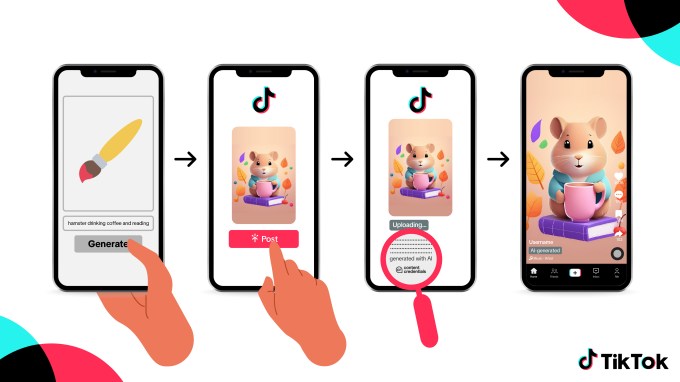TikTok is beginning to routinely label AI-generated content material that was made on different platforms, the corporate introduced on Thursday. With this variation, if a creator posts content material on TikTok that was created with a service like OpenAI’s DALL·E 3, it should routinely have an “AI-generated” label connected to it to inform viewers that it was created with AI.
The social video platform is doing so by implementing Content material Credentials, a expertise from the Coalition for Content material Provenance and Authenticity (C2PA), which was co-founded by Microsoft and Adobe. Content material Credentials connect particular metadata to content material, which TikTok can then use to immediately acknowledge and label AI-generated content material.
In consequence, TikTok will begin routinely labeling AI-generated content material that’s uploaded to the platform with Content material Credentials connected. The change is rolling out on Thursday and can apply to all customers globally within the coming weeks.
Whereas TikTok already labels content material that was made with TikTok AI results, it should now label content material that was created on different platforms which have carried out Content material Credentials, like OpenAI’s DALL·E 3 and Microsoft’s Bing Picture Creator. Whereas Microsoft, Adobe and OpenAI are already on board with Content material Credentials, Google has pledged to assist Content material Credentials as effectively.

Though TikTok already requires creators to reveal when they’re posting content material that has been created or enhanced with AI, the corporate advised TechCrunch that it sees the brand new change as an extra manner of making certain that AI-generated content material is being labeled, whereas additionally taking the strain off of creators.
Within the coming months, TikTok may even begin attaching Content material Credentials to AI-generated content material created on the platform utilizing TikTok AI results. The Content material Credentials metadata will embody particulars on the place and the way the AI-generated content material was made or edited and can stay connected to the content material when downloaded. Different platforms that undertake Content material Credentials will be capable of routinely label the content material as AI-generated.
So, whereas TikTok dedicated to labeling AI content material by itself service, it’s additionally in search of to assist be certain that AI content material that was made in TikTok can also be precisely labeled when posted on one other platform.
“AI-generated content material is an unimaginable artistic outlet, however transparency for viewers is important,” Adam Presser, Head of Operations and Belief & Security at TikTok, stated in a press launch. “By partnering with friends to label content material throughout platforms, we’re making it simple for creators to responsibly discover AI-generated content material, whereas persevering with to discourage the dangerous or deceptive AIGC that’s prohibited on TikTok.”
TikTok is touting that it’s the primary video-sharing platform to implement Content material Credentials. It’s price mentioning that Meta introduced again in February that it plans to construct on the C2PA’s answer for including provenance to content material.
As a part of Thursday’s announcement, TikTok stated that it’s dedicated to combating the usage of misleading AI in elections and that its insurance policies firmly prohibit harmfully deceptive AI-generated content material—whether or not it’s labeled or not.






/cdn.vox-cdn.com/uploads/chorus_asset/file/25441671/Crow_Country_screenshot_09_Spindle.png?w=440&resize=440,0&ssl=1)
/cdn.vox-cdn.com/uploads/chorus_asset/file/25441671/Crow_Country_screenshot_09_Spindle.png?w=320&resize=320,0&ssl=1)




Leave a Comment